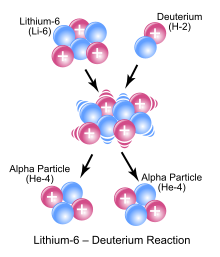
Aneutronic fusion is any form of fusion power in which very little of the energy released is carried by neutrons. While the lowest-threshold nuclear fusion reactions release up to 80% of their energy in the form of neutrons, aneutronic reactions release energy in the form of charged particles, typically protons or alpha particles. Successful aneutronic fusion would greatly reduce problems associated with neutron radiation such as damaging ionizing radiation, neutron activation, reactor maintenance, and requirements for biological shielding, remote handling and safety.
Since it is simpler to convert the energy of charged particles into electrical power than it is to convert energy from uncharged particles, an aneutronic reaction would be attractive for power systems. Some proponents see a potential for dramatic cost reductions by converting energy directly to electricity, as well as in eliminating the radiation from neutrons, which are difficult to shield against.[1][2] However, the conditions required to harness aneutronic fusion are much more extreme than those required for deuterium–tritium (D–T) fusion such as at ITER.
- ^ Harms, A. A.; Schoepf, Klaus F.; Kingdon, David Ross (2000). Principles of Fusion Energy: An Introduction to Fusion Energy for Students of Science and Engineering. World Scientific. pp. 8–11. ISBN 978-981-238-033-3.
- ^ Larry T. Cox Jr., Franklin B. Mead Jr. and Chan K. Choi Jr., (1990). "Thermonuclear Reaction Listing with Cross-Section Data for Four Advanced Reactions"], Fusion Technology, Volume 18, no. 2. Retrieved 2019-05-07.